Polarmetric Consistency Assessment and Calibration Method for Quad-Polarized ScanSAR Based on Cross-Beam Data
Abstract
Highlights
- This paper investigates the effectiveness of utilizing cross-beam area images for polarimetric calibration on quad-polarized wide-swath SAR data.
- This study can effectively reduce the workload and time required for conducting quad-polarized wide-swath SAR data calibration.
Abstract
1. Introduction
- The SC mode has a large illumination area. In order to obtain assessment results across the region, conventional methods have to deploy an active calibrator in this large area. Moreover, a calibration often consists of several experiments. The calibrators have to be moved over long distances and re-deployed between these experiments. Both od these processes are very labor-intensive and time-consuming.
- In SC mode, one single task contains multiple beams switching rapidly in turn. Assessment and calibration performed beam-by-beam can multiply the workload several times compared to the SM mode. Meanwhile, constrained by the satellite review period, some of the beams may not be able to reach the calibration field in several weeks. This means that the overall assessment of a SAR satellite may be delayed by weeks due to the lack of results for a few beams.
- Methods that use an active calibrator or volume scattering distributed targets to assess polarimetric performance can only achieve results that are not correlated between beams. A calibration based on these results may lead to leaps in the overlapping area, which affects the polarimetric consistency of the mosaic-ed image.
- To reduce the need for active calibrators to conduct polarimetric calibration work in SC mode. The method selects volume-scattering distributed targets that satisfy the system reciprocity requirement to perform an assessment of the amplitude and phase imbalance within a single beam in SC mode. Based on the assessment results, the calibrated data are used to generate a Pauli pseudo-color image. The image is accurately color-coded, thereby demonstrating the effectiveness of the assessment and calibration process.
- To avoid performing polarimetric calibration beam-by-beam, a method using cross-beam data to assess polarimetric distortion difference between beams has been proposed. By introducing the concept of polarization contrast ratio (PCR), the method selects certain distributed targets located in the cross-beam area to assess the amplitude and phase differences at different polarizations. Furthermore, we can transmit the polarimetric distortion matrix across different beams, which can effectively improve the efficiency of the assessment and calibration work.
- With the transfer of the polarimetric distortion matrix, the method also improves the polarimetric consistency of the mosaic-ed image. Based on the transferred assessment results, a mosaic-ed Pauli pseudo-color image is generated. The image shows good consistency across beams, which also validates the effectiveness of the method.
2. Study Data and Data Pre-Processing
2.1. Quad-Polarized ScanSAR Experiment Data
2.2. Quad-Polarized SM Data for Validation
2.3. Data Pre-Processing
3. Methodology
3.1. Polarimetric Assessment Method Within One Swath
3.2. Calibration Method for Polarization Differences Between Swaths
3.2.1. Cross-Beam Area
3.2.2. Polarization Contrast Ratio Threshold Solving Based on OTSU
3.2.3. Derivation Methodology for the Polarization Discrepancy Matrix
4. Results and Validation
4.1. Polarimetric Assessment and Calibration Results from Swath-1
4.2. Polarimetric Calibration Results Between Swaths
Derivation Results for the Polarization Discrepancy Matrix
4.3. Overall Calibration Results and Validation Based on SM Data
5. Discussion and Conclusions
Author Contributions
Funding
Data Availability Statement
Conflicts of Interest
References
- Morena, L.C.; James, K.V.; Beck, J. An introduction to the RADARSAT-2 mission. Can. J. Remote Sens. 2004, 30, 221–234. [Google Scholar] [CrossRef]
- Freeman, A. A new system model for radar polarimeters. IEEE Trans. Geosci. Remote Sens. 1991, 29, 761–767. [Google Scholar] [CrossRef]
- Thompson, A.A. Overview of the RADARSAT Constellation Mission. Can. J. Remote Sens. 2015, 41, 401–407. [Google Scholar] [CrossRef]
- Pitz, W.; Miller, D. The Terrasar X satellite. IEEE Trans. Geosci. Remote Sens. 2010, 48, 615–622. [Google Scholar] [CrossRef]
- Zhao, L.; Zhang, Q.; Li, Y.; Li, H. China’s Gaofen-3 Satellite System and Its Application and Prospect. IEEE J. Sel. Top. Appl. Earth Obs. Remote Sens. 2021, 14, 11019–11028. [Google Scholar] [CrossRef]
- Xie, N.; Zhang, T.; Guo, W.; Zhang, Z.; Yu, W. Dual Branch Deep Network for Ship Classification of Dual-Polarized SAR Images. IEEE Trans. Geosci. Remote Sens. 2024, 62, 5207415. [Google Scholar] [CrossRef]
- Suman, S.; Malin, J.; Nicholas, H.; Munk, H.S.; Henriette, S. Arctic Sea Ice Characterization Using Spaceborne Fully Polarimetric L-, C-, and X-Band SAR with Validation by Airborne Measurements. IEEE Trans. Geoence Remote Sens. 2018, 56, 3715–3734. [Google Scholar]
- Gill, J.P.S.; Yackel, J.J. Evaluation of C-band SAR polarimetric parameters for discrimination of first-year sea ice types. Can. J. Remote Sens. 2012, 38, 306–323. [Google Scholar] [CrossRef]
- Azmedroub, B.; Ouarzeddine, M.; Souissi, B. Extraction of Urban Areas from Polarimetric SAR Imagery. IEEE J. Sel. Top. Appl. Earth Obs. Remote Sens. 2016, 9, 2583–2591. [Google Scholar] [CrossRef]
- Liu, Y.; Zhang, M.H.; Xu, P.; Guo, Z.W. SAR ship detection using sea-land segmentation-based convolutional neural network. In Proceedings of the 2017 International Workshop on Remote Sensing with Intelligent Processing (RSIP), Shanghai, China, 18–21 May 2017; IEEE: Piscataway, NJ, USA, 2017. [Google Scholar]
- Wang, J.; Quan, S.; Xing, S.; Li, Y.; Wu, H.; Meng, W. PSO-based fine polarimetric decomposition for ship scattering characterization. Isprs J. Photogramm. Remote Sens. 2025, 220, 18–31. [Google Scholar] [CrossRef]
- Denize, J.; Hubert-Moy, L.; Pottier, E. Polarimetric SAR Time-Series for Identification of Winter Land Use. Sensors 2019, 19, 5574. [Google Scholar] [CrossRef]
- Holzner, J.; Bamler, R. Burst-mode and ScanSAR interferometry. IEEE Trans. Geosci. Remote Sens. 2002, 40, 1917–1934. [Google Scholar] [CrossRef]
- Velotto, D.; Migliaccio, M.; Nunziata, F.; Lehner, S. Dual-Polarized TerraSAR-X Data for Oil-Spill Observation. IEEE Trans. Geosci. Remote Sens. 2011, 49, 4751–4762. [Google Scholar] [CrossRef]
- Bräutigam, B.; Rizzoli, P.; Gonzalez, C.; Polimeni, D.; Schrank, D.; Schwerdt, M. SAR Performance of TerraSAR-X Mission with Two Satellites. In Proceedings of the 8th European Conference on Synthetic Aperture Radar, Aachen, Germany, 7–10 June 2010. [Google Scholar]
- Touzi, R.; Hawkins, R.K.; Cote, S. High-Precision Assessment and Calibration of Polarimetric RADARSAT-2 SAR Using Transponder Measurements. IEEE Trans. Geosci. Remote Sens. 2013, 51, 487–503. [Google Scholar] [CrossRef]
- Torres, R.; Navas-Traver, I.; Bibby, D.; Lokas, S.; Geudtner, D. Sentinel-1 SAR system and mission. In Proceedings of the 2017 IEEE Radar Conference (RadarConf), Seattle, WA, USA, 8–12 May 2017; IEEE: Piscataway, NJ, USA, 2017. [Google Scholar]
- Jiao, Y.; Zhang, F.; Liu, X.; Huang, Z.; Yuan, J. C-SAR/02 Satellite Polarimetric Calibration and Validation Based on Active Radar Calibrators. Remote Sens. 2025, 17, 282. [Google Scholar] [CrossRef]
- Liu, J.; Liu, L.; Zhou, X. Calibration of SAR Polarimetric Images by Covariance Matching Estimation Technique with Initial Search. Remote Sens. 2024, 16, 2400. [Google Scholar] [CrossRef]
- Wang, S.; Chen, K.S.; Sato, M. Performance of SAR Polarimetric Calibration Using Hybrid Corner Reflectors: Numerical Simulations and Experimental Measurements. IEEE J. Sel. Top. Appl. Earth Obs. Remote Sens. 2021, 14, 440–451. [Google Scholar] [CrossRef]
- Chang, Y.; Zhao, L.; Shi, L.; Nie, Y.; Hui, Z.; Xiong, Q.; Li, P. Polarimetric calibration of SAR images using reflection symmetric targets with low helix scattering. Int. J. Appl. Earth Obs. Geoinf. 2021, 104, 102559. [Google Scholar] [CrossRef]
- Chen, Y.; Li, L.; Liu, G.; Li, Z. Performance of an Effective SAR Polarimetric Calibration Method Using Polarimetric Active Radar Calibrators: Numerical Simulations and LT-1 Experiments. Remote Sens. 2025, 17, 584. [Google Scholar] [CrossRef]
- Chen, Y.; Wang, Y.; Liu, G.; Li, L. A New Polarimetric SAR Calibration Method Using Polarimetric Active Radar Calibrators. In Proceedings of the 2024 9th International Conference on Signal and Image Processing (ICSIP), Nanjing, China, 12–14 July 2024; pp. 74–77. [Google Scholar]
- Chi, B.; Zhang, J.; Lu, L.; Yang, S.; Huang, G. A new distributed target extraction method for polarimetric sar calibration. ISPRS Ann. Photogramm. Remote Sens. Spat. Inf. Sci. 2022, 10, 31–36. [Google Scholar] [CrossRef]
- Zhou, Y.; Chen, P.; Yin, Q.; Chen, E.; Ferro-Famil, L.; Zhang, F. Polarimetric SAR cross-calibration method based on stable distributed targets. Geo-Spat. Inf. Sci. 2024, 27, 773–793. [Google Scholar] [CrossRef]
- Cuerda Munoz, J.M.; Garcia Rodriguez, M.; Casal Vazquez, N.; Cifuentes Revenga, P.; Gi-Meno Martinez, N.; Gonzalez Bonilla, M.J.; Schmidt, K. PAZ Calibration Status After First Year of Operation. In Proceedings of the EUSAR 2021; 13th European Conference on Synthetic Aperture Radar, Online, 29 March–1 April 2021; pp. 114–119. [Google Scholar]
- Badatala, S.; Sharma, S.; Tripathi, S.; Patel, P.R.; Mathur, A.K. Radiometric calibration stability assessment of Sentinel-1B using point targets at Surat Basin, Australia. Int. J. Microw. Wirel. Technol. 2022, 14, 1262–1269. [Google Scholar] [CrossRef]
- Martínez, N.G.; Miguel, B.G.; Pescador, A.L.; Revenga, P.C.; Borge, J.C.N. Cross-calibration of full polarimetric RIX and TerraSAR-X data. In Proceedings of the 2012 IEEE International Geoscience and Remote Sensing Symposium, Munich, Germany, 22–27 July 2012. [Google Scholar]
- Caves, R. RADARSAT-2 Polarimetric Calibration Performance Over Five Years of Operation. In Proceedings of the EUSAR 2014; 10th European Conference on Synthetic Aperture Radar, Berlin, Germany, 3–5 June 2014. [Google Scholar]
- Luscombe, A.P.; Chotoo, K.; Huxtable, B.D. Polarimetric calibration for RADARSAT-2. In Proceedings of the IEEE International Geoscience Remote Sensing Symposium, Honolulu, HI, USA, 24–28 July 2000. [Google Scholar]
- Huang, J.; Yan, B.; Sun, N. Monitoring of the Cross-Calibration Biases Between the S-NPP and NOAA-20 VIIRS Sensor Data Records Using Goes Advanced Baseline Imager as a Transfer. In Proceedings of the IGARSS 2020–2020 IEEE International Geoscience and Remote Sensing Symposium, Waikoloa, HI, USA, 26 September–2 October 2020; IEEE: Piscataway, NJ, USA, 2020. [Google Scholar]
- Gao, C.; Jiang, X.; Li, X.; Li, X. The cross-calibration of CBERS-02B/CCD visible-near infrared channels with Terra/MODIS channels. Int. J. Remote Sens. 2013, 34, 3688–3698. [Google Scholar] [CrossRef]
- Thome, K.J.; Biggar, S.F.; Wisniewski, W. Cross comparison of EO-1 sensors and other Earth resources sensors to Landsat-7 ETM+ using Railroad Valley Playa. IEEE Trans. Geosci. Remote Sens. 2003, 41, 1180–1188. [Google Scholar] [CrossRef]
- Zhou, Y.; Chen, X.; Yin, Q.; Ma, F.; Zhang, F. SAR Radiometric Cross-Calibration Based on Multiple Pseudoinvariant Calibration Sites with Extensive Backscattering Coefficient Range. IEEE J. Sel. Top. Appl. Earth Obs. Remote Sens. 2025, 18, 4836–4849. [Google Scholar] [CrossRef]
- Jiang, S.; Qiu, X.; Han, B.; Hu, W. A Quality Assessment Method Based on Common Distributed Targets for GF-3 Polarimetric SAR Data. Sensors 2018, 18, 807. [Google Scholar] [CrossRef]
- Zyl, J.J.V. Calibration of polarimetric radar images using only image parameters and trihedral corner reflector responses. IEEE Trans. Geosci. Remote Sens. 1990, 28, 337–348. [Google Scholar]
- Souyris, J.C.; Imbo, P.; Fjortoft, R.; Mingot, S.; Lee, J.S. Compact polarimetry based on symmetry properties of geophysical media: The /spl pi//4 mode. IEEE Trans. Geosci. Remote Sens. 2005, 43, 634–646. [Google Scholar] [CrossRef]
- Guissard, A. Phase calibration of polarimetric radars from slightly rough surfaces. IEEE Trans. Geosci. Remote Sens. 1994, 32, 712–715. [Google Scholar] [CrossRef]
- Zebker, H.A.; Lou, Y. Phase calibration of imaging radar polarimeter Stokes matrices. IEEE Trans. Geosci. Remote Sens. 2002, 28, 246–252. [Google Scholar] [CrossRef]
- Otsu, N. A Threshold Selection Method from Gray-Level Histograms. IEEE Trans. Syst. Man, Cybern. 1979, 9, 62–66. [Google Scholar] [CrossRef]
- Mahmood, E.A.; Rana, S.; Midi, H.; Hussin, A.G. Detection of Outliers in Univariate Circular Data using Robust Circular Distance. J. Mod. Appl. Stat. Methods 2017, 16, 418–438. [Google Scholar] [CrossRef]

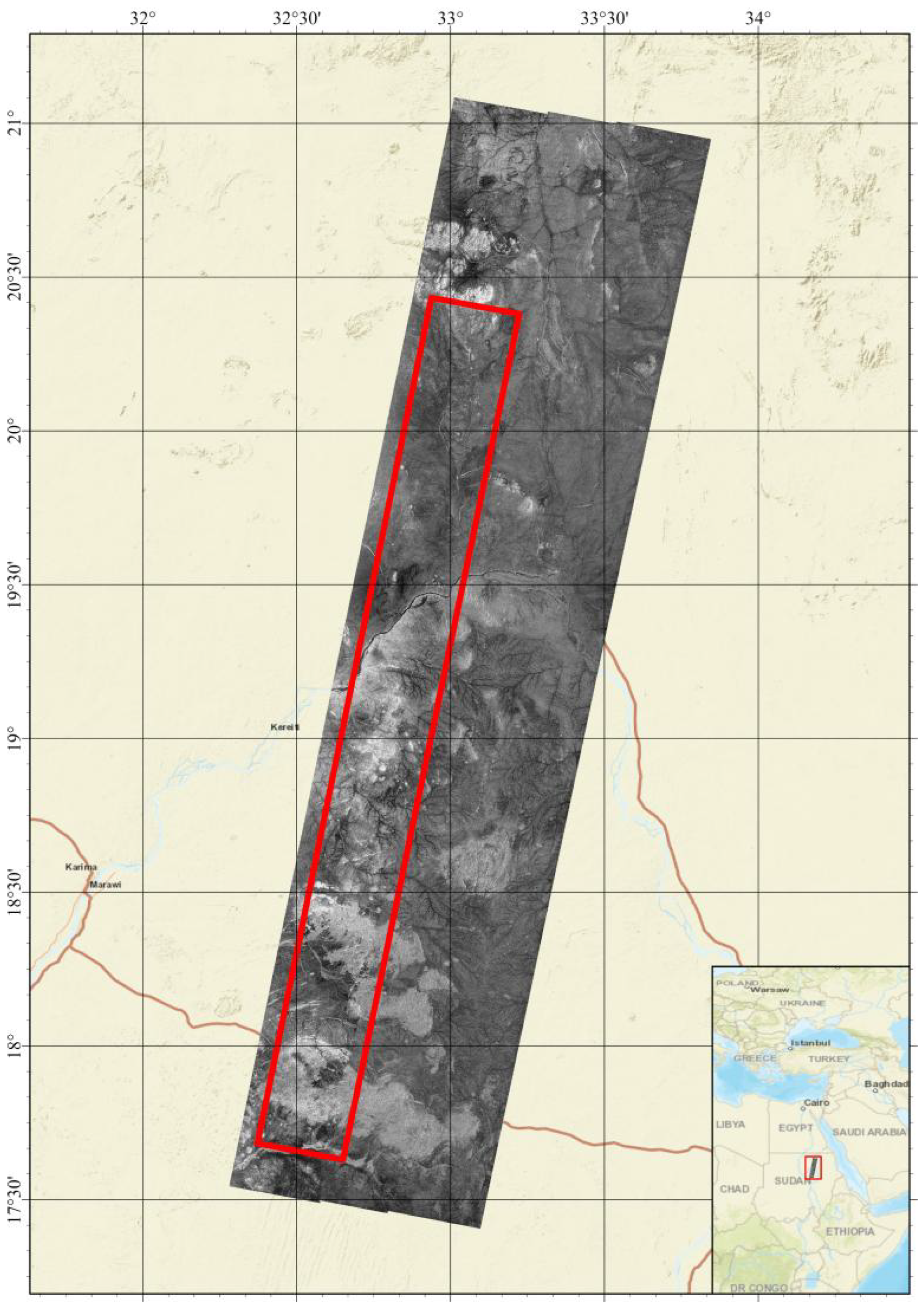
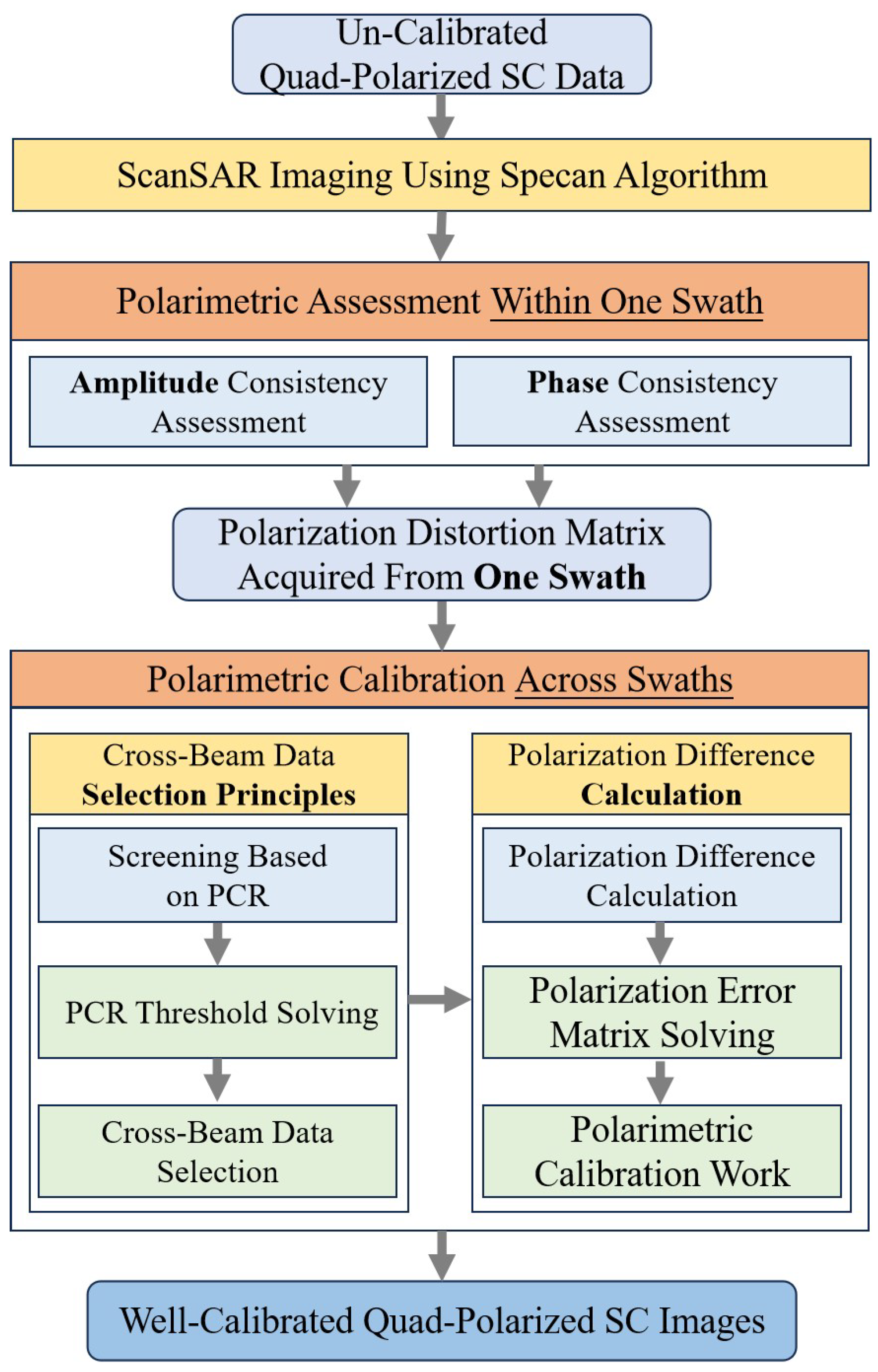
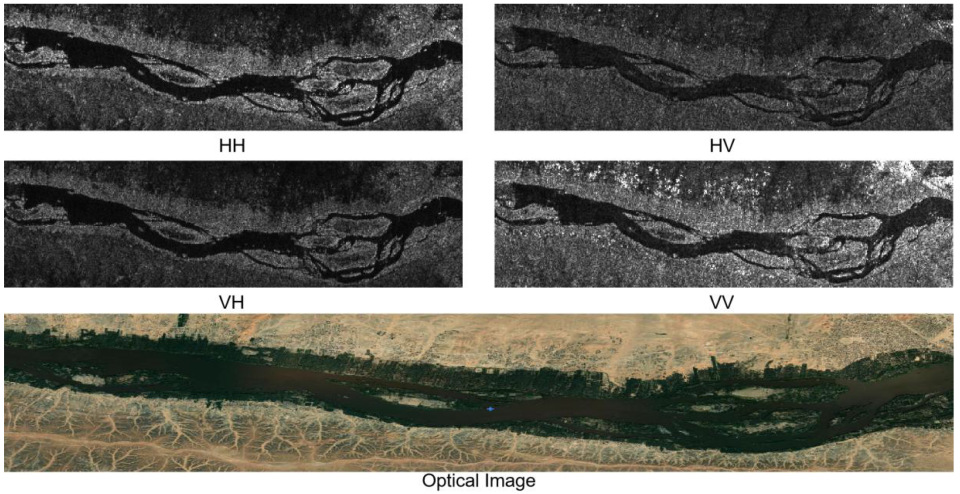
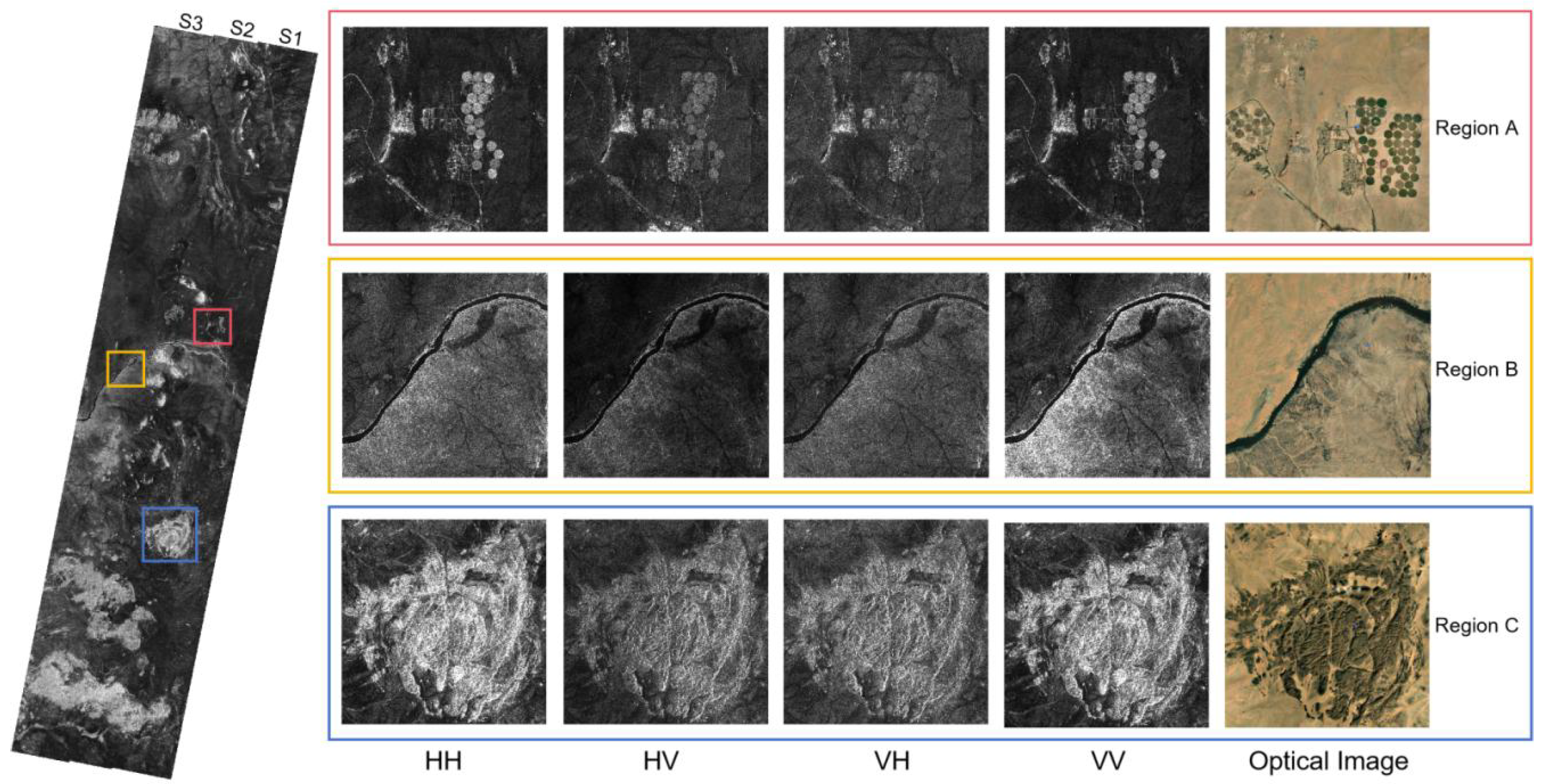

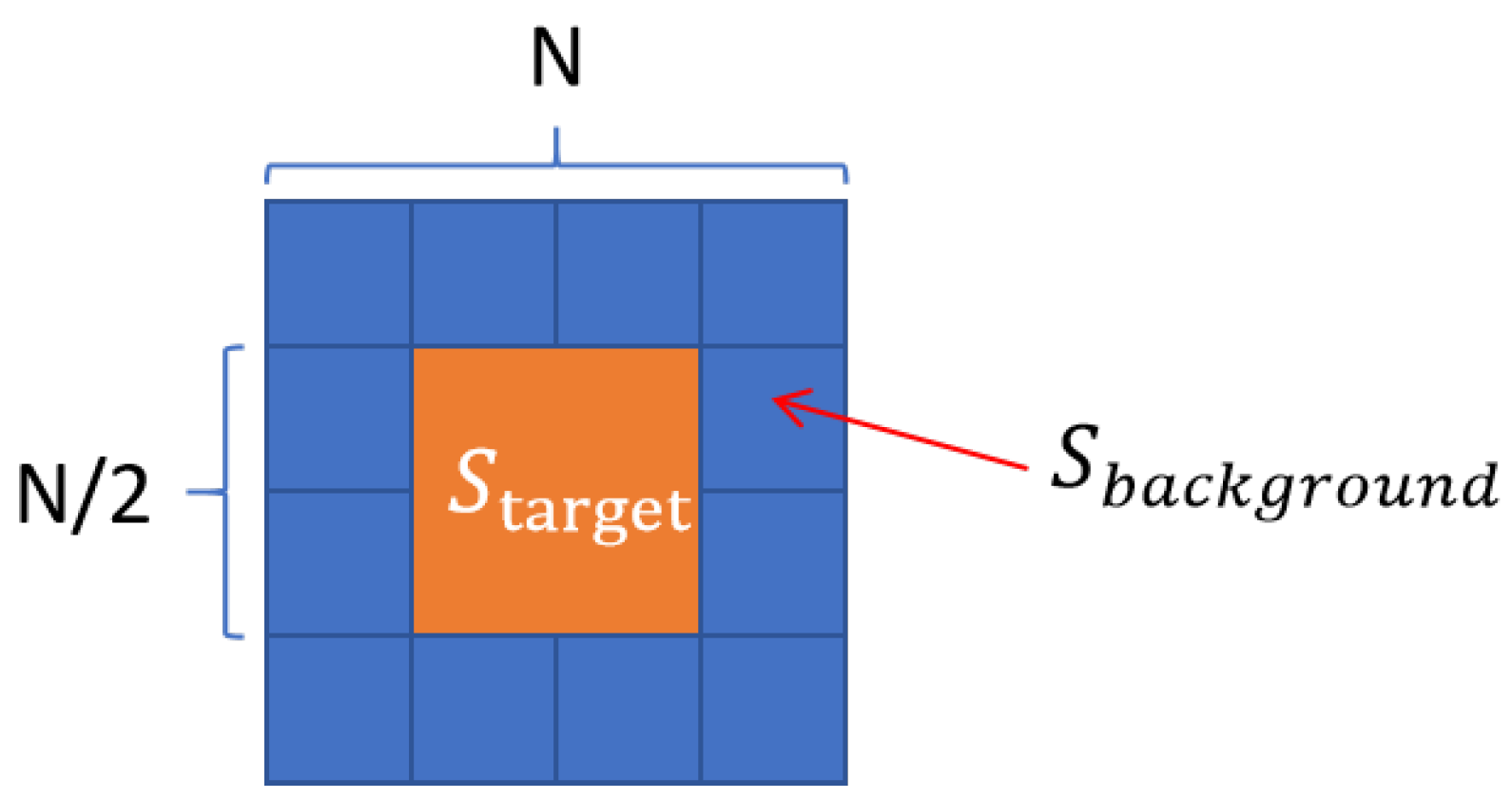


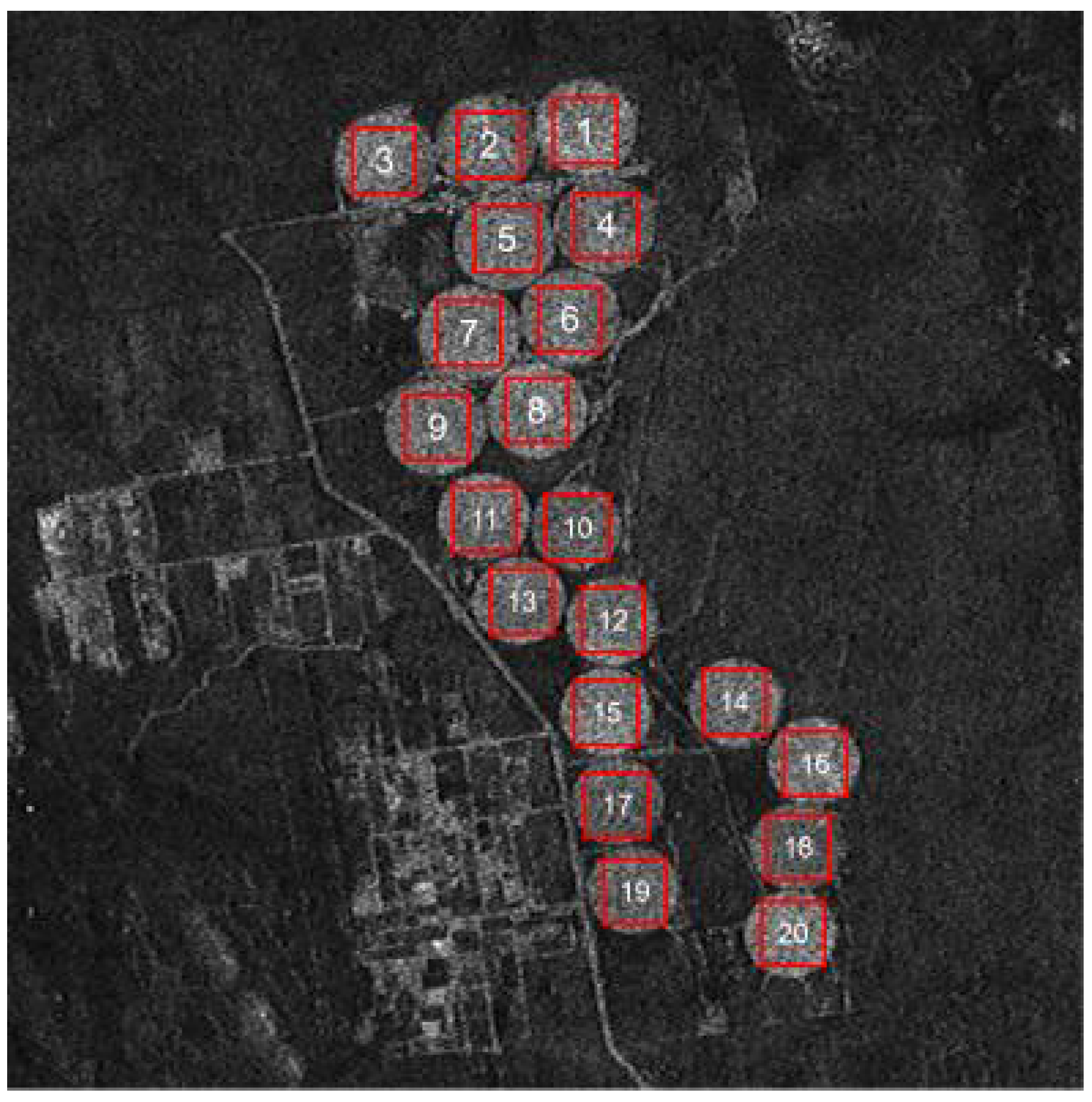
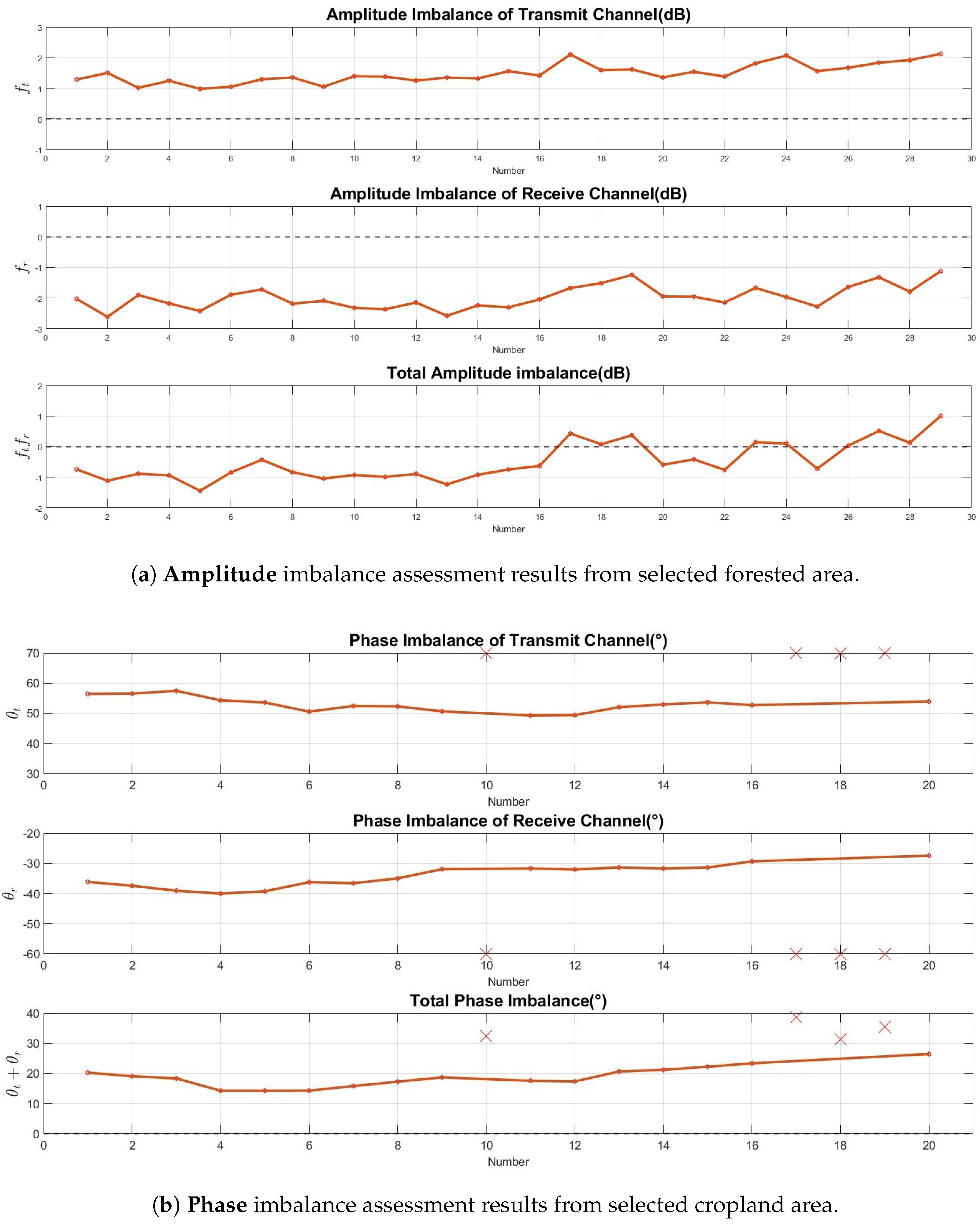
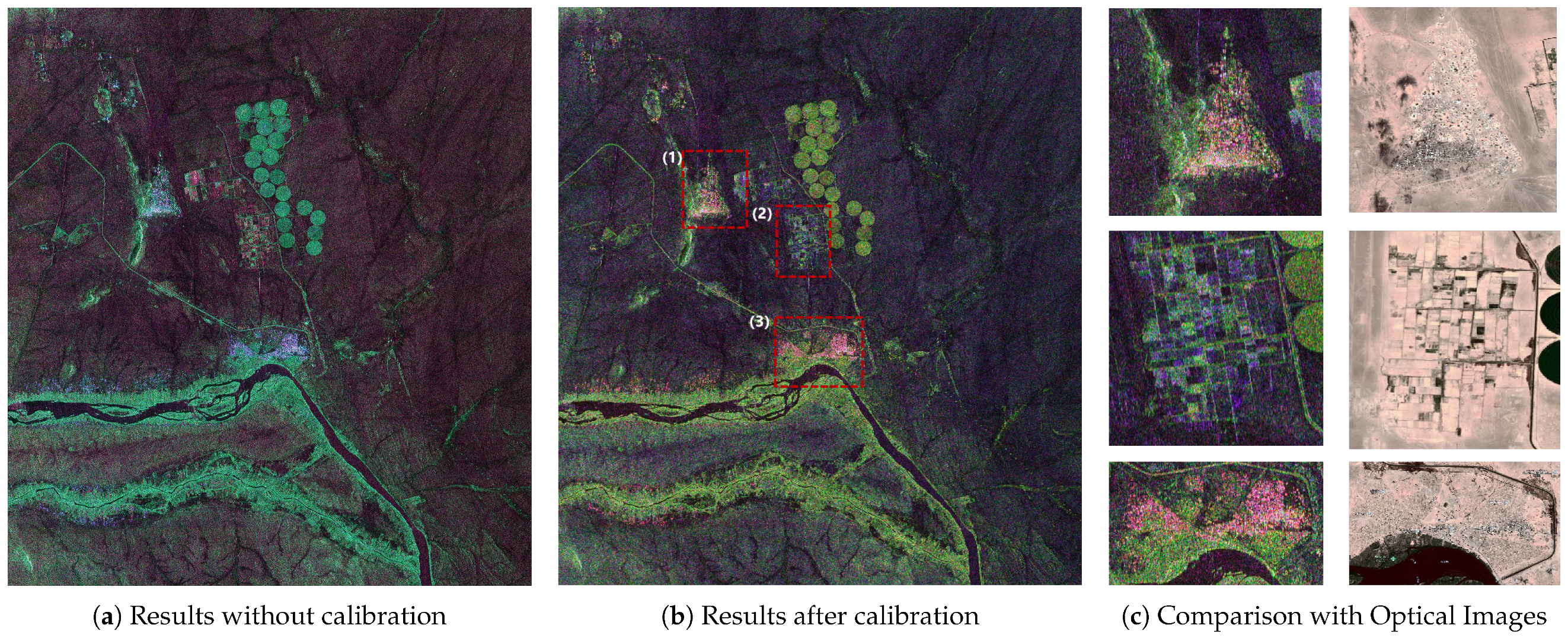
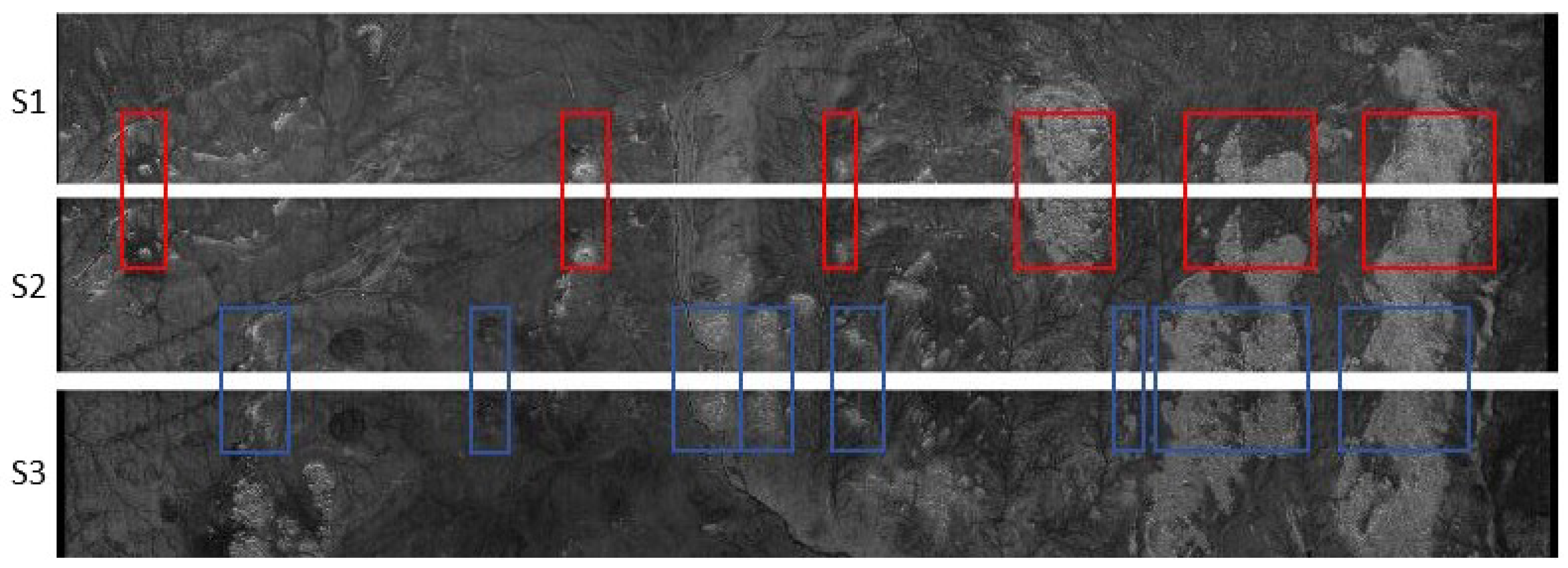
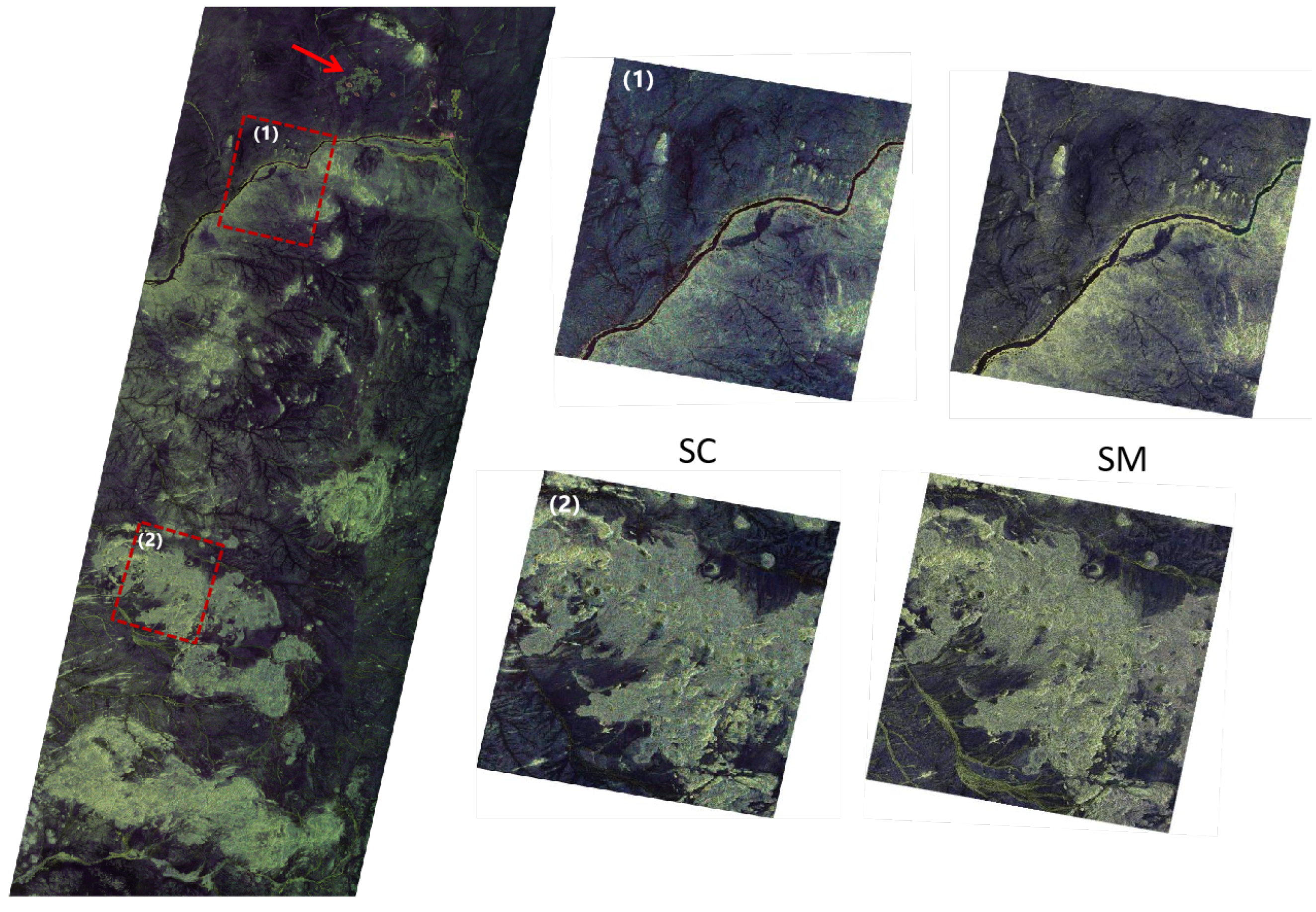
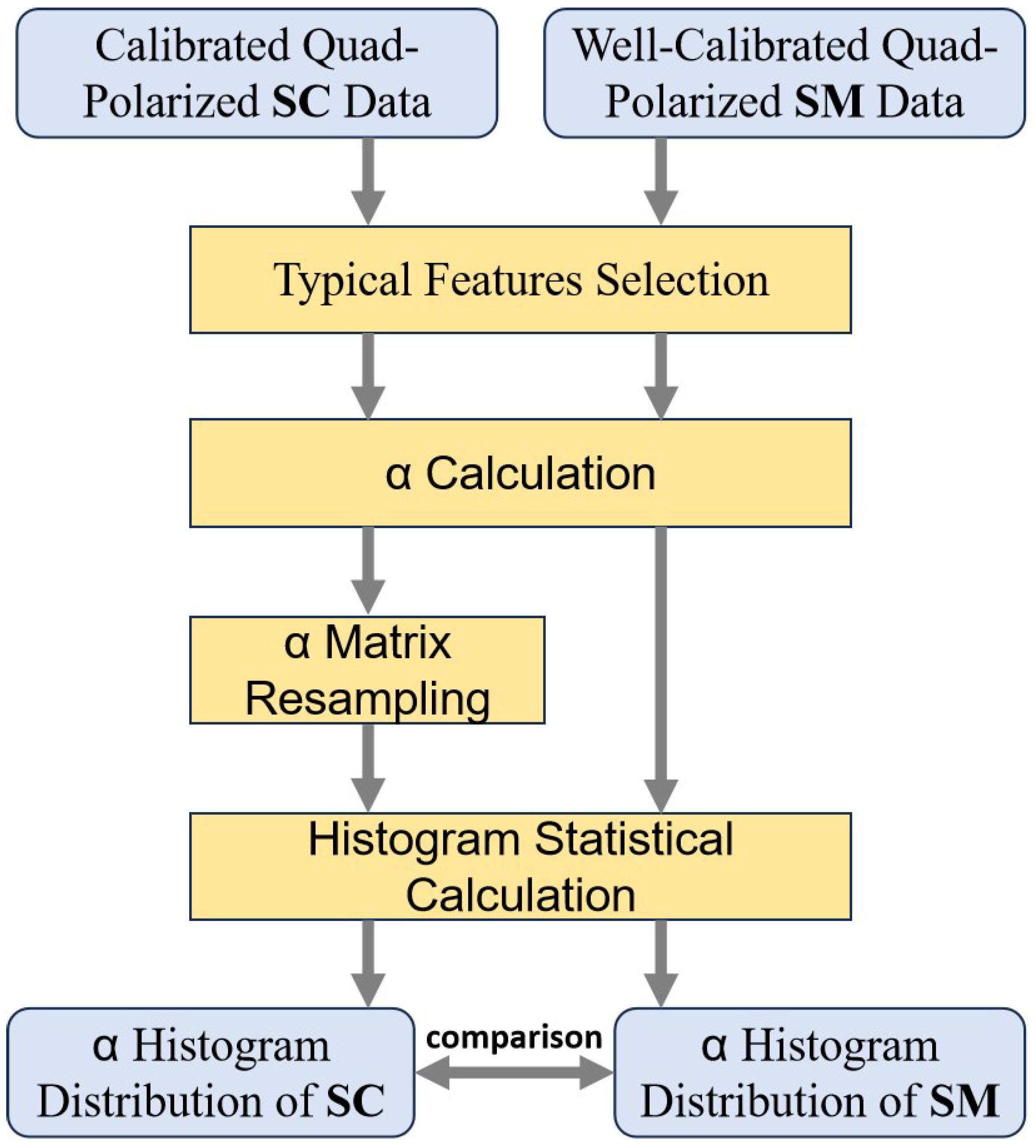

| Swath Number | Resolution(m) | Swath Width (km) | Polarization Mode | |
|---|---|---|---|---|
| NSC | 3 | 50 | 300 | HHHV/VVVH |
| WSC | 5 | 100 | 500 | HHHV/VVVH |
| GLO | 7 | 500 | 650 | HHHV/VVVH |
| Swath | Beam | Center Look Angle (°) | PRF (Hz) | Bandwidth (MHz) |
|---|---|---|---|---|
| S1 | Q9 | 29.36 | 2797.8 | 60.00 |
| S2 | Q10 | 30.56 | 2738.1 | 40.00 |
| S3 | Q11 | 31.70 | 2554.4 | 30.00 |
| Overlapping Swaths | No. | ||||||||
|---|---|---|---|---|---|---|---|---|---|
| S1&S2 | 1 | −0.0416 | −32.7859 | 0.2279 | 164.1152 | −0.5036 | 53.7889 | −0.0532 | 37.9361 |
| 2 | 0.2830 | −35.0861 | 0.8305 | 165.6738 | 0.0472 | 52.1294 | 0.3505 | 37.1410 | |
| 3 | −0.1433 | −36.3598 | 0.1132 | 165.9473 | −0.5818 | 52.0011 | −0.1820 | 39.2041 | |
| 4 | 0.4237 | −39.2093 | 0.4395 | 166.6406 | −0.1819 | 55.1274 | 0.4470 | 36.5987 | |
| 5 | 0.3551 | −39.7685 | 0.6870 | 168.2831 | 0.0098 | 58.1101 | 0.4099 | 34.0034 | |
| 6 | 0.4343 | −37.4931 | 0.5987 | 166.5710 | −0.0514 | 57.1645 | 0.4803 | 35.8576 | |
| Results | (S1→S2) | 0.3191 | −36.9265 | 0.5191 | 166.2592 | −0.1167 | 54.4582 | 0.3802 | 36.8699 |
| S2&S3 | 1 | −0.4877 | 4.8955 | 0.4476 | −91.4284 | −1.0256 | 6.9744 | 0.1027 | −98.0951 |
| 2 | −0.975 | 4.1116 | −0.6315 | −94.1125 | 1.1473 | 9.1473 | −0.4656 | −96.9788 | |
| 3 | −0.5407 | 6.2542 | 0.4694 | −92.6288 | −0.2155 | 7.7845 | 0.1401 | −94.4985 | |
| 4 | −0.3985 | 8.4067 | 0.5658 | −92.3695 | −1.4127 | 6.5873 | 0.2338 | −92.8406 | |
| 5 | −0.692 | 9.6096 | 0.0326 | −89.2850 | 1.2258 | 9.2258 | −0.0785 | −91.8729 | |
| 6 | −0.5562 | 6.6080 | 0.3428 | −91.9332 | −0.2432 | 7.7568 | 0.0134 | −92.0900 | |
| 7 | −0.1565 | 7.3988 | 1.0122 | −92.8681 | −3.2485 | 4.7515 | 0.5645 | −92.0114 | |
| 8 | −0.2238 | 4.6959 | 0.9205 | −95.5601 | −5.3418 | 2.6582 | 0.5042 | −89.1590 | |
| Results | (S2→S3) | −0.5142 | 6.4311 | 0.4585 | −92.4992 | −0.6344 | 7.3656 | 0.1214 | −92.4653 |
| (S1→S3) | −0.1952 | −30.4954 | 0.9776 | 73.76 | −0.7511 | 61.8238 | 0.5016 | −55.5955 |
Disclaimer/Publisher’s Note: The statements, opinions and data contained in all publications are solely those of the individual author(s) and contributor(s) and not of MDPI and/or the editor(s). MDPI and/or the editor(s) disclaim responsibility for any injury to people or property resulting from any ideas, methods, instructions or products referred to in the content. |
© 2025 by the authors. Licensee MDPI, Basel, Switzerland. This article is an open access article distributed under the terms and conditions of the Creative Commons Attribution (CC BY) license (https://creativecommons.org/licenses/by/4.0/).
Share and Cite
Yin, D.; Duan, J.; Sun, J.; Zhao, L.; Wang, X.; Shangguan, S.; Zhong, L.; Hong, W. Polarmetric Consistency Assessment and Calibration Method for Quad-Polarized ScanSAR Based on Cross-Beam Data. Remote Sens. 2025, 17, 3420. https://doi.org/10.3390/rs17203420
Yin D, Duan J, Sun J, Zhao L, Wang X, Shangguan S, Zhong L, Hong W. Polarmetric Consistency Assessment and Calibration Method for Quad-Polarized ScanSAR Based on Cross-Beam Data. Remote Sensing. 2025; 17(20):3420. https://doi.org/10.3390/rs17203420
Chicago/Turabian StyleYin, Di, Jitong Duan, Jili Sun, Liangbo Zhao, Xiaochen Wang, Songtao Shangguan, Lihua Zhong, and Wen Hong. 2025. "Polarmetric Consistency Assessment and Calibration Method for Quad-Polarized ScanSAR Based on Cross-Beam Data" Remote Sensing 17, no. 20: 3420. https://doi.org/10.3390/rs17203420
APA StyleYin, D., Duan, J., Sun, J., Zhao, L., Wang, X., Shangguan, S., Zhong, L., & Hong, W. (2025). Polarmetric Consistency Assessment and Calibration Method for Quad-Polarized ScanSAR Based on Cross-Beam Data. Remote Sensing, 17(20), 3420. https://doi.org/10.3390/rs17203420






